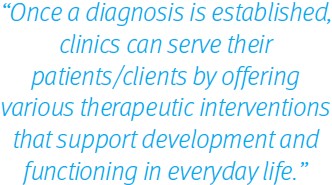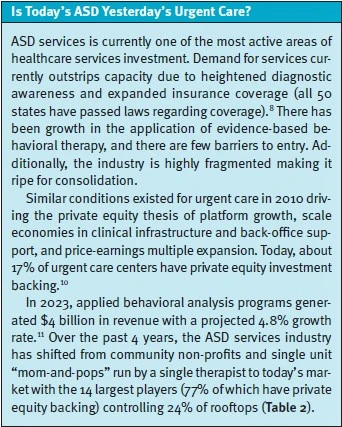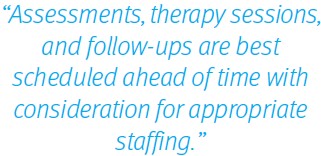Urgent Message: Rapid growth in the autism spectrum disorder services (ASD) sector may present an expansion opportunity for urgent care operators who take the initiative to develop the necessary infrastructure.
Citation: Ayers A. ASD Services Fit With Existing UC Business Models, J Urgent Care Med. 2024; 19 (1): 33-36
As the prevalence of autism spectrum disorder (ASD) continues to rise—now affecting 1 in 36 children in the United States—demand for accessible services is greater than ever.[i] While long-term behavioral health services for those with ASD are typically a separate, specialized domain, urgent care providers might wonder if there is a business structure for offering autism care as a separate line of business—particularly operators that focus on pediatric populations.
Delivering autism care services requires a nuanced approach that involves evidence-based, comprehensive services and highly trained providers in coordination with a pediatrician or family physician. However, adding autism care services adjacent to the urgent care model can meet the needs of a community, diversify revenue, strengthen patient relationships, and change the perception of urgent care to that of more comprehensive healthcare providers.
As the need for autism care grows, urgent care operators might explore the potential business opportunity or at least be aware of community partners available for referral and collaboration.
Autism Services Models
The Centers for Disease Control and Prevention (CDC) estimates as many as 3 million Americans are on the autism spectrum, and at least 10 times as many children are now considered to have ASD compared to 40 years ago.1 A significant part of the reason for the increase in prevalence is the greater awareness of the ASD diagnosis among clinicians and the advances in screening and diagnostic tools.[2] Services for those with ASD represents a care category projected to grow in the next decade and beyond.
According to August, 2024 data provided to JUCM from National Urgent Care Realty, more than 3,000 locations nationwide provide a scope of behavioral health services for children on the autism spectrum. Like the early years of urgent care, the behavioral health segment focused on autism services is highly fragmented today (Table 1). Also according to National Urgent Care Realty data examining the largest operators, 43% of rooftops are single-unit operators while 33% of rooftops are controlled by entities with more than 10 locations. It is expected that the industry will see both organic growth in rooftops as well as consolidation of existing operators in the coming years.
| Operating Entity | Center Count | Investment Firm |
| BlueSprig (Florida Autism Center, Trumpet, Fusion) | 170 | KKR |
| Hopebridge Autism Therapy Centers | 106 | Arsenal Capital Partners |
| Autism Learning Partners | 76 | FFL Partners |
| Behavioral Innovations | 62 | Tenex Capital Mgmt |
| Acorn Health | 61 | Ontario Teachers Plan |
| Proud Moments ABA | 47 | Audax Private Equity |
| ACES | 38 | General Atlantic |
| Center for Autism and Related Disorders | 28 | Blackstone Group |
| ChanceLight (Growing Minds Learning Center) | 28 | Halifax |
| ABS Kids | 27 | Morgan Stanley |
| Behavior Frontiers | 27 | Lorient Capital |
| Mosaic Pediatric Therapy | 24 | |
| Positive Behavior Support Corp. | 22 |
Source: National Urgent Care Realty data, August 2024
And the services have proven to be suitable clinical complements within the portfolios of urgent care owners and operators.
Little Spurs Pediatric Urgent Care in San Antonio and Dallas/Fort Worth, Texas, has launched a specialized autism center with 2 locations delivering services separately from its network of pediatric urgent care facilities. The Little Spurs Autism Centers offer comprehensive assessments, diagnosis, and applied behavioral analysis (ABA) therapy for patients/clients up to 21 years old. Additional services include individualized education program assistance to support children throughout their school years.
Notably, Little Spurs’ Autism Centers leverage the company’s existing urgent care branding. The ASD line of business offers strategic advantages beyond expanded revenue by positioning the urgent care brand as a comprehensive healthcare provider capable of meeting a wide range of community needs beyond acute illness and injury care. The expansion of services can also be a key differentiator in the competitive urgent care market.
Building a business case for autism services starts with a thorough understanding of the diverse range of ASD interventions and support systems needed to deliver appropriate care and outcomes.

ASD Screening and Diagnosis
Medical and scientific literature has long supported early diagnosis as a critical factor in the effective management of ASD.[3] The Diagnostic and Statistical Manual of Mental Disorders 5th Edition from the American Psychiatric Association outlines the criteria for diagnosis, emphasizing a wide spectrum because there is significant variation in the type and severity of symptoms that people with ASD experience. Assessments like the Autism Diagnostic Observation Schedule, Second Edition (ADOS-2) is one tool used to diagnose ASD, and the CDC also offers a number of screening tools as well.[4]

Therapeutic Interventions
Once a diagnosis is established, clinics can serve their patients/clients by offering various therapeutic interventions that support development and functioning in everyday life. Prime among these is ABA, which focuses on teaching essential life skills through positive reinforcement. This long-term approach has been shown to create meaningful behavior change over time.[5] Furthermore, ABA is tailored to each child’s needs and evolves in response to their progress.
ABA is typically performed by a registered behavioral technician (RBT) under the supervision of a board certified behavioral analyst (BCBA), who is nationally certified and state-licensed with a master’s degree or PhD in psychology or behavioral analysis. RBTs are the front-line therapists working with patients daily. As of July 2024, there were 69,000 BCBAs and 170,000 RBTs holding certification in the United States.[6]
In addition to ABA, other therapies support holistic autism care. Occupational therapy is a cornerstone of autism treatment that helps those with ASD develop skills for daily living, which might include eating, dressing, and personal hygiene, as well as skills for navigating environments that might cause distress. Speech therapy addresses both verbal and non-verbal communication skills.

For younger children, early intensive behavior intervention and the Early Start Denver Model (EDSM) have been shown to be effective.[7] These programs are designed for children under 5 years of age and combine play-based activities with structured teaching methods to promote appropriate cognitive and social development. Typically provided in a 1-to-1 setting, these forms of therapy are personalized for each child.
Educational Support Services
Beyond therapeutic interventions, educational support is a vital component of autism care, particularly for children of school-age years. Nearly all specialized autism clinics assist with individualized education plans and/or admission, review, dismissal programs—the structures that ensure children receive the necessary accommodations and tailored educational strategies they need to succeed within traditional school environments. Clinics must coordinate with school districts to ensure they can comply with policies and that their plans are compatible and effective.
Moreover, parental education and supportive services are just as integral to the child’s success, given the parent’s role in reinforcing therapy techniques at home and advocating for their child’s needs.
Insurance Coverage and Accessibility
Navigating insurance coverage to ensure reimbursement and treatment accessibility is a critical consideration for any urgent care aiming to add autism services. Many autism services, including ABA, are covered by most insurance plans. All 50 states mandate covered services for ASD to some extent.[8] However, the scope of coverage varies widely, and some insurance plans are exempt.
Insurance coverage may pose limitations associated with critical variables, such as the number of therapy hours covered, criteria for qualifying for coverage of specific services, and which types of providers may file claims. Typical urgent care businesses must be prepared to operationalize far more administrative and coverage processes for ASD services than what they routinely navigate with urgent care to ensure the line of business is financially sustainable.
Likewise, urgent care owners should be sensitive to the challenges families may face in securing coverage. Many encounter high deductibles, co-pays, coinsurance, and prior authorization limitations that can become barriers to care. Collecting the out-of-pocket payments within revenue cycle management processes would be similar to the processes used for collecting payment in urgent care.
| Number of Operator Locations | Number of Operators | Number of Centers | Percent of Centers |
| >100 | 2 | 276 | 9% |
| 75-100 | 1 | 76 | 3% |
| 50-75 | 2 | 123 | 4% |
| 40-50 | 1 | 47 | 2% |
| 30-40 | 1 | 38 | 1% |
| 20-30 | 6 | 156 | 5% |
| 10-20 | 22 | 292 | 10% |
| 5-10 | 50 | 317 | 10% |
| 3-5 | 53 | 173 | 6% |
| 2 | 108 | 216 | 7% |
| 1 | 1,319 | 1,319 | 43% |
Source: National Urgent Care Realty data, July 2024
Access
Unlike traditional urgent care services, which welcome walk-ins, autism services require a more structured approach. Assessments, therapy sessions, and follow-ups are best scheduled ahead of time with consideration for appropriate staffing.
COVID-19 had a marked impact on recruiting and retention within the autism services space, consequently affecting most agencies’ bottom lines; most business underperformance is due to staffing and supply restraints, not a lack of demand. Agencies that have been able to retain talent have and will continue to grow their businesses.
Referrals
While some families may seek out autism services independently, many are referred by a primary care physician, pediatrician, or school. Urgent cares with a strong reputation in their community will find it easier to build a strong referral network and maintain the viability of the program.
Through the lens of urgent care, understanding and addressing the needs of the community is not just about offering a new service, it’s about building a sustainable, patient-centered model that meets the growing demand for specialized autism care.
Patient Expectations
In the urgent care setting, treatment typically addresses immediate concerns—something patients have come to expect. Effective autism care focuses on long-term developmental gains and quality-of-life improvements. ASD is a lifelong condition, and the trajectory of each person’s development is unique, and not everyone will respond to interventions in the same way or at the same pace. As such, it’s crucial to establish realistic expectations for the business and the clients/patients and their families.
The long-term benefits of comprehensive autism care are well documented. Research indicates that early intervention, particularly before age 5, can lead to more significant and sustained improvements in cognitive, language, and social skills.[9]
Conclusion
Autism care offers a potential revenue diversification opportunity for urgent care operators as well as an opportunity to fulfill an unmet need for care services in a community. By expanding, urgent care centers can enhance patient satisfaction and solidify their position as comprehensive healthcare providers.
- [1]. Centers for Disease Control and Prevention. Data and Statistics on Autism Spectrum Disorder. May 16, 2024. Accessed August 15, 2024. https://www.cdc.gov/autism/data-research/index.html
- [2]. Robison JE, Gassner D. There is no epidemic of autism. It’s an epidemic of need. Stat. March 23, 2023. Accessed August 15, 2024. https://www.statnews.com/2023/03/23/autism-epidemic-cdc-numbers/
- [3]. Fernell E, Eriksson M, Gillberg C. Early diagnosis of autism and impact on prognosis: a narrative review. Clin Epidemiol. 2013;5(1):33-43 https://doi.org/10.2147/CLEP.S41714
- [4]. Centers for Disease Control and Prevention. Screening and Diagnosis of Autism Spectrum Disorder. Accessed August 15, 2024. https://www.cdc.gov/autism/hcp/diagnosis/screening.html
- [5]. Autism Speaks Website. ABA. Accessed August 15, 2024. https://www.autismspeaks.org/applied-behavior-analysis#:~:text=More%20than%2020,show%20similar%20benefits
- [6]. Behavior Analyst Certification Board, Inc. Certificant Data. Accessed August 15, 2024. https://www.bacb.com/bacb-certificant-data/
- [7]. American Speech-Language-Hearing Association website. Accessed August 15, 2024. https://www.asha.org/advocacy/state/states-specific-autism-mandates/#:~:text=Making%20effective%20communication%2C%20a%20human,Hawaii
- [8]. National Conference of State Legislatures website. Autism and Insurance Coverage State Laws. Accessed August 15, 2024. https://www.ncsl.org/health/autism-and-insurance-coverage-state-laws
- [9]. Eckes, T., Buhlmann, U., Holling, HD. et al. Comprehensive ABA-based interventions in the treatment of children with autism spectrum disorder – a meta-analysis. BMC Psychiatry 23, 133 (2023). https://doi.org/10.1186/s12888-022-04412-1
- [10] .Ayers A. Private Equity Ownership in Urgent Care By Number of Centers, 2024. J Urgent Care Med. 2024; 18(7):33-34
- [11]. Global Market Insights website. U.S. Applied Behavior Analysis Market. January 2024. Accessed at: https://www.gminsights.com/industry-analysis/us-applied-behavior-analysis-market
Download the Article PDF: ASD Services Fit With Existing UC Business Models

